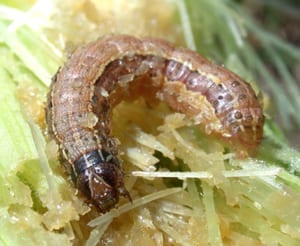 Trap counts often spike late in July as fall army worm moths take flight. Their larvae feed on crops causing defoliation and crop damage. With much of the crop going in late this year, AgVenture encourages growers to be on the lookout for the pest.
Trap counts often spike late in July as fall army worm moths take flight. Their larvae feed on crops causing defoliation and crop damage. With much of the crop going in late this year, AgVenture encourages growers to be on the lookout for the pest.
Fall army worm larvae prefer feeding on late planted corn. They may attack tassels and/or ears of corn leaving ragged holes. In heavy infestations, corn plants may even look like they have been damaged by hail. However, they also feed on soybeans causing damage especially during reproductive stages.
 Fall armyworms vary in appearance from light tan to nearly black and have three light yellow lines down the back. Unlike other armyworms or corn earworms, the fall armyworm’s head has a noticeable white, inverted Y shape between its eyes. Insecticides are typically warranted in severe infestations or in crops under stress.
Fall armyworms vary in appearance from light tan to nearly black and have three light yellow lines down the back. Unlike other armyworms or corn earworms, the fall armyworm’s head has a noticeable white, inverted Y shape between its eyes. Insecticides are typically warranted in severe infestations or in crops under stress.
(photos: Purdue University)